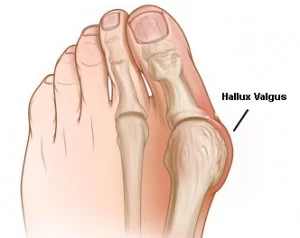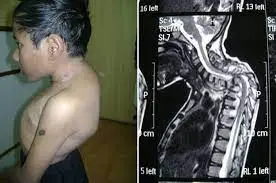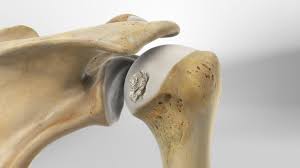Hallux Valgus foot
Table of Contents
What is a Hallux Valgus foot?
Hallux valgus is the most common deformity of the forefoot and great toe.
It can be defined as the lateral deviation of the great toe.
It is most commonly seen in women as compared to men (women 33%> men13%) and elderly people (35.5)
It is common in people with flat feet and hammer toes.
at a later stage, these changes may lead to painful foot and functional deficit: i.e. impaired gait (impaired weight distribution, late heel rise, impaired balance, and prone to further deformity)
Anatomy
The Hallux (first toe)
It has three synovial joints.
Tarsometatarsal joint – which is situated between the medial cuneïform bone and the first metatarsal, the joint does not allow a
a lot of movement.
Metatarsophalangeal joint – it is a connection between the first metatarsal and the first proximal phalanx, the joint allows flexion
and extension of the first toe and abduction- and adduction towards the center of the second toe.
Interphalangeal joint -it is a connection between the two phalanges of the first toe. the joint allows flexion and extension movement.
structures reinforcing the metatarsophalangeal joint and interphalangeal joint (lig. metatarsophalangeal collateral and lig.
Metatarsophalangeal plantaria, lig. Interphalangeal collateralia and lig. Interphalangae plantaris)
Hallux Valgus and its normal Angle
The angle formed crossing over the proximal phalanx and the first metatarsal bone
Less than 15° is considered a normal angle while angles of 20° or greater than 20 are considered abnormal while progressively the angle of 45-50° is considered a very severe deformity that it needed to be treated surgically.
Symptoms of Hallux valgus foot
the distal end of the first metatarsal bone drifts or rotates medially.
proximal phalange rotates laterally.
bony enlargement at the toe
The mechanism behind the hallux valgus condition occurs:
It Starts with the stretched out of the abductor hallucis muscle which results from wearing tight shoes.
later the base of the first proximal phalanx starts to lateralize and gets into abduction.
while walking, the forefoot is turned into pronation, which stretches up the medial collateral ligament and the capsular structures of the first Metatarsophalangeal joint.
which consists of multiple bones, ligaments, sesamoid bones, and muscles.
Hallux is pushed into a valgus position because Capsule gets weaker and the abductor hallucis tendon turns into a flexion of the hallux.
Differential Diagnosis:
- Gout-Pain appears sudden while onset is gradual in hallux valgus. As well as semi-uric acid levels can be used to differentiate between the two.
- septic arthritis
- Turf toe
- Arthropathy
How will you treat the Hallux Valgus?
It can be managed by two methods:-
- non-operative method
- operative method
How to Prevent hallux valgus foot?
A result of a generalized laxity of the ligaments is not preventable but other things are. For example, using or wearing appropriate shoes that fit correctly (not too tight or not too loose) and avoiding the use of high heels can be important factors in preventing hallux valgus.
Adjusting the footwear helps in eliminating and to reduces friction at the level of the medial eminence.
By using appropriate orthosis.
The tendon of the Achilles contracture may require stretching to get lengthened.
This type of treatment mentioned above can be applied in the early stage when the secondary contractures of the soft tissues and alterations of the articular surfaces have not become permanent or else the condition is not permanent.
OPERATIVE METHODS:
- First Metatarsal Joint fusion in cases of midfoot instability.
2. First Metatarsal-Phalangeal Joint Arthrodesis
When the permanent elimination of motion occurs that is the reason that this procedure is one of the last options to treat a significant deformity in this procedure the proximal phalanx is correctly positioned towards the first metatarsal and then it is fixed joint with help of screws, plates or crossing K-wires.
POST-OPERATIVE MANAGEMENT:
For all surgical procedures, the patient post-operatively is allowed to ambulate in a post-operative shoe immediately after the surgery.
Patients need to wear a post-op shoe and compressive dressings to support and it should be up to 6- 8 weeks.
Why Physiotherapy is essential after surgery?
Physiotherapy is beneficial after the corrective operation because Hallux valgus correction can be very complicated Especially if it is associated with instability which can be caused by bony or soft tissue abnormalities when it is combined with midfoot fusion and post-operative recovery might be challenging.
Patients’ beliefs should be addressed priorly and sometimes because many patients get frustrated and disappointed when quick recovery is not achieved.
It is essential to discuss the post-operative complications with the patient priorly to the operation.
- non-weight bearing up to six weeks
2. Discomfort
3. immobilization in the modified shoes
4. Swelling might last up to six months
Pain Management
following this operation, especially the pain that is due to scar healing and due to any external fixation which is done by the surgeons to fix up the deformities (an intense bony pain would be concerning).
- Desensitizing techniques to help manage pain
2. TENS(transcutaneous electrical nerve stimulation) machine can also help manage pain.
3.US (ultrasonic therapy) can also reduce swelling or edema and enhance faster healing.
To improve Mobility
First and Second toe mobility and flexibility
Assess the first toe, you want it to be in an appropriate setting or comfortable position which may differ from the patient preference.
Stretching will be helpful if needed but avoid overstretching as it may be painful to the patient In some cases, the toe alignment might be disturbed if the surgery wasn’t successful.
accordingly great toe the second toe should be also treated to achieve proper mobility and flexibility.
massage will be helpful to improve healing as well as to improve blood flow and reduce pain
muscle and joint stretches
taping techniques may be useful to support the underlying structures
bunion splint or orthotic may be useful for proper support and immobilization.
To improve muscle strength
Towel curling exercises:- first spread out a small towel on the floor, curling his/her toes around it and pulling and pushing the towel towards them and against them.
Toes spread out exercises (TSO):- A possible causative factor of the hallux valgus is the imbalance in muscles between the two main muscles: the abductor hallucis and the adductor hallucis. Strengthening the abductor’s muscle will prevent a hallux valgus and it can be helpful to correct the deformity in an early stage. The toes-spread-out (TSO) exercise is an efficient way to train abductor hallucis by asking the patient to actively spread all the toes outwards and hold them for some duration and get toes inwards by relaxing them.
physiotherapists must provide proper care to the ankle joint by actively performing ankle dorsiflexion and plantarflexion.
Gait Training
Gait deficiency may result from the immobilization in the modifiable shoe or plaster of Paris for six weeks.
To Restore the gait, balance deficit is a key component of rehabilitation.
One of the gait deficits that result due to hallux valgus correction is when patients adopt a habit of walking on the side of their foot they avoid loading the recently operated big toe this needs to be addressed to ensure good balance and stability and to prevent the other injuries in the long term plan.








3 Comments